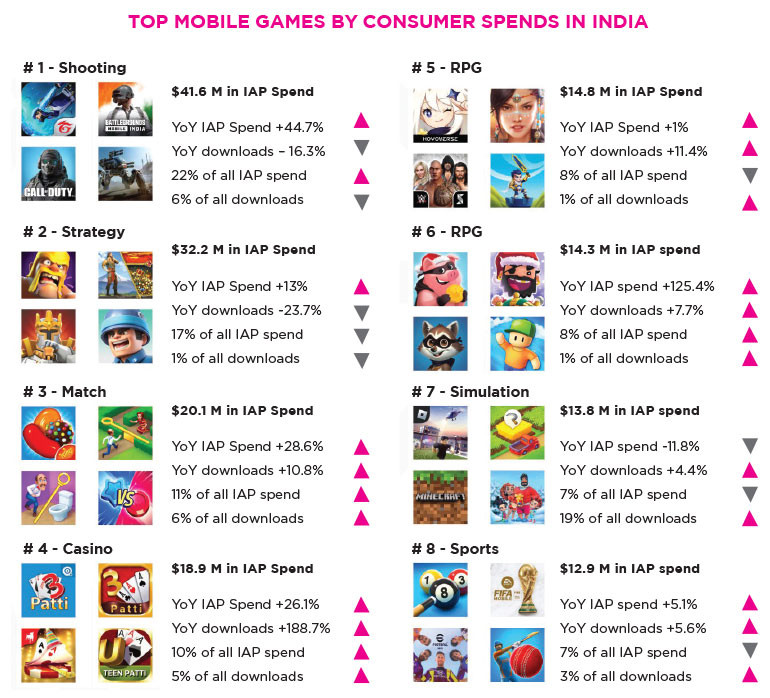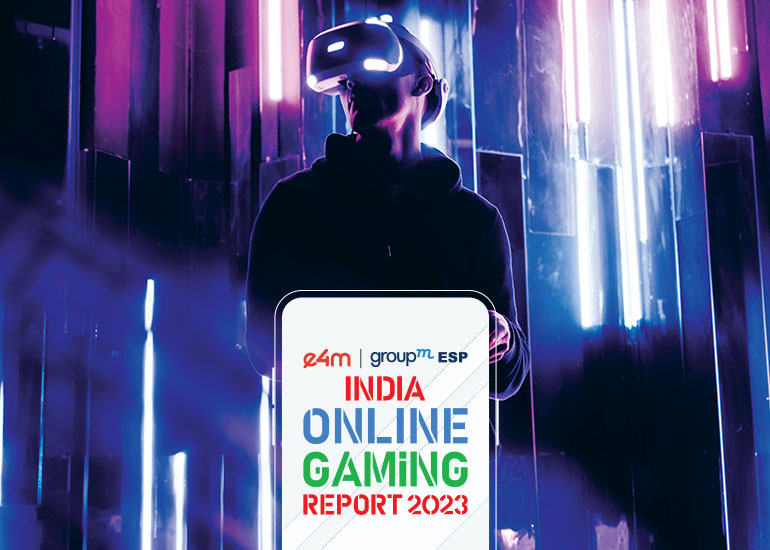With over 750M active internet users in 2022, India has become the prime destination for the open internet and all that digital media entails. A key driver of India’s digital revolution is gaming, with the country being home to close to 500 million individual gamers. India’s ever-evolving gaming market is fuelled by devices, data and digital penetration, all of which are getting cheaper, better, and faster. In a mobile-first market, the gaming industry in India has witnessed a remarkable rise in recent years, making it the biggest mobile gaming market in the world. This report by GroupM ESP and e4m seeks to decode the growth of the online gaming landscape in India, with a focus on how brands can leverage this billion-dollar industry, and the road ahead.
Experts believe that 2022 was perhaps one of the biggest years so far for the Indian esports and gaming industry, with publishers, streaming platforms, esports organizers, and teams coming together to create a healthy ecosystem. It is believed that with professional teams training to compete and win in global tournaments, 2023 may well be a breakout year for the esports industry.
According to a report by the Internet and Mobile Association of India (IAMAI), the number of mobile gamers in India is projected to increase to a staggering 650 million by 2025. As the gaming landscape in India continues to evolve, the Indian advertising industry is set to see more brand integrations, collaborations, and campaigns catering to this large audience in the coming years.

THE SIZE OF ESPORTS IN INDIA
According to a report by Statista, India recorded about 421 million online gamers in 2022, and the number is expected to cross 442 million by 2023. About 90 million of these gamers reportedly paid for online games that year, the report added.
Gamers from across India are taking a keen interest in online mobile gaming, given the fact that they now have access to affordable internet, data penetration, and smartphone adoption. With a compound annual growth rate (CAGR) of 27%, the gaming market in India will expand from $2.6 billion (Rs 20,800 Cr.) in the fiscal year 2022 to $8.6 billion (Rs. 68,800 Cr.) in the fiscal year 2027. Notably, the growth of gaming in second tier Indian cities is more as compared to metro cities such as Delhi and Mumbai.
According to data available, India is the world’s biggest mobile game market by Google Play downloads. Markets such as India, Brazil and Indonesia present a ripe opportunity for local and foreign mobile game publishers and investors. According to statistics by data.ai, India recorded 9,529 million downloads on Google Play Store, while on iOS App store, the country recorded 121 million mobile game downloads in 2022.
A research by Lumikai, a gaming-focused investment fund stated that India overtook China as the world’s largest user of mobile games in 2018, with over 15 billion downloads. The report revealed that India’s gaming industry in 2022 hit major inflection points, registering strong growth across the board. India crossed half a billion gamers in FY22, up from 450 million the year prior.
Coming to revenue, esports is expected to reach Rs. 1,100cr. ($ 137.5M) by FY2025, according to a report by Ernst & Young. The esports industry in India would generate an economic impact of Rs. 10,000 Cr ($1250M) between FY2021 and FY2025, which will induce income in parallel and complimentary industries, change social dynamics in the country, thus creating new jobs for many, the report added. The industry is expected to surpass the biggest sport franchise in India in terms of prize money, by offering a total prize pool of Rs. 100cr. ($12.5M) by FY2025.
THE MOST POPULAR GAMES
Of the 450-500 million gamers in India, 24 percent are paid users. As per the India Gaming Report FY 2022 by Lumikai, the average revenue per paying user grew 11% to $20/year (Rs. 1600/year) in FY22, while the average weekly time spent by gamers was 8.5 hours during FY22. The report added that mid-core titles like Free Fire, BGMI, and Genshin Impact saw strong daily engagement with over 80 minutes of average daily playtime per user, with more than 10% of mid-core gamers playing for more than 10 hours per week. Moreover, the male to female ratio of surveyed gamers yielded a 60:40 ratio, equally split between metro and non-metro cities. The report further reveals that India became the largest consumer of mobile games in FY 2022 in total downloads. As of today, the most popular games in the country are Ludo King, Bubble Shooter, Indian Bikes Driving 3D, Candy Crush Saga, Garena Free Fire, Call of Duty: Mobile, and Clash Royale.
Moreover, consumer spend in mobile gaming settled at $190M (Rs 1520cr.) in India – 27% growth over 2019 numbers – with downloads surging to 9.65 billion – 71% growth over 2019.
The Indian Mobile Gaming Report 2022 released by Mobile Premier League lists the top five Indian states with the highest mobile gamers. Uttar Pradesh features on top, followed by Maharashtra, Rajasthan, Bihar, and West Bengal.

FACTORS IMPACTING ESPORTS IN INDIA
There are a few factors driving the growth of esports in the country, and 5G is one such factor. It is acting as a catalyst by fuelling the industry’s growth with high-speed connectivity, available at relatively low prices. 5G provides faster download and upload speeds, allowing gamers to download and install games faster, besides the obvious high resolution streaming. It also allows gamers to access new updates, patches, and DLCs quicker, reducing downtime and improving the overall gaming experience. 5G further reduces latency, which is the delay between a player’s action and the game’s response. This enables real-time gameplay that is more responsive and immersive. Another important aspect here is that 5G will enable cloud gaming, which allows gamers to stream games directly to their devices without the need for a console or high-end PC.
On the other hand, Augmented Reality (AR) and Virtual Reality (VR) technologies have made significant advancements in the gaming industry, enhancing the gaming experience and offering new immersive possibilities. VR technology provides players with a fully immersive and interactive experience by creating a virtual world that players can explore. VR headsets transport players into a 3D virtual environment, enabling them to interact with the game using head movements and hand controllers.
Meanwhile, AR overlays virtual elements onto the real world, blending digital content with the player’s surroundings. AR gaming often utilizes the camera and sensors of mobile devices or dedicated AR headsets like Microsoft HoloLens to provide an interactive and immersive experience. Apart from AR and VR, there is Mixed Reality gaming, which combines elements of both AR and VR, allowing virtual objects to interact with the real world and vice versa.
As tech becomes affordable and easy to create, more VR games will be produced and consumed. The gaming industry has been at the forefront of the development and adoption of augmented reality (AR) and virtual reality (VR) technologies, which have the potential to revolutionize the way we play and experience games.
These technologies have also given rise to a new category of wearable devices that are specifically designed for gaming, such as VR headsets and smart watches. Wearable tech can enhance the gaming experience by providing real-time feedback and control, such as tracking a player’s movements or monitoring their heart rate. As AR and VR technology and wearable tech continue to advance, we can expect to see even more innovative and immersive gaming experiences in the future.
Additionally, the growth of gaming infrastructure has been a crucial factor in the expansion and development of the gaming industry. Gaming infrastructure refers to the hardware and software components required to support gaming, including gaming consoles, gaming PCs, servers, and networks. One of the key drivers of gaming infrastructure growth is the increasing popularity of online gaming. As more gamers opt for online multiplayer games, the demand for high-speed internet and low-latency networks has also increased.

ESPORTS MARKETING IN INDIA
Esports has taken the world by storm, captivating over 1 billion people globally. With its soaring popularity, brands are increasingly recognizing the immense marketing potential that esports has to offer.
The esports audience represents a highly valuable and rapidly expanding demographic. This predominantly young and digitally savvy audience not only engages deeply with esports but also exhibits a willingness to embrace new products and trends. Targeting younger audiences facilitates loyalty building and the acquisition of first-party data, as they are the early adopters of emerging technologies. There are four steps to entering the world of esports – identify your ideal esports audience, discover the right channels, collaborate with influential figures in esports, and launch or sponsor esports team.
ROLE OF INFLUENCERS
In today’s media environments, influencers are growing in importance. Gaming influencers are one of the major forces driving the gaming industry. With the presence of social media and live streaming platforms like Twitch and YouTube, influencers are now able to connect with a large number of gamers, sharing their gaming experiences and building a larger fan-base. Gaming influencers often stream their gaming performances and offer tips, commentary on the games, reviews, tutorials, and walkthroughs to the other gamers. Influencers are also sponsored by gaming companies that provides them a chance to earn a good sum from brand deals and partnerships equalling and surpassing many of the mainline lifestyle influencers and celebs.
Today, gaming has emerged as a career option for many online gamers. A recent study by Newzoo reveals that 83% of the respondents consider gaming as either a primary or secondary source of income, out of which, 39% consider gaming as a primary source, and 44% as a secondary source of income. Here Real Money Gaming (RMG) must be mentioned, which refers to gaming activities where players can invest real money on games of skill or chance with the opportunity to win monetary rewards. The game operator earns money by charging users a network fee based on how much they bet in each game, and this category has benefited a lot from mobile gaming.
With fantasy being one of the major subgenres, media spends and sponsorships is more than common for this segment. As per industry estimates, RMG as a category of advertisers cumulatively spent Rs 3118 Cr. ($390M) during the 2022 calendar year, out of which, 48% of the spends were on digital media. To put things in context, media spends from RMG category would amount to approximately 2.5% of the 2022 ADEX figures – for an industry that is not even a decade old. Furthermore, from a genre point-of-view, 72% of the their spends on television was on ‘sports’, followed by 10% on the ‘Hindi movies’ genre, which clearly indicates focus skewed towards the men in the household.
2022 saw the esports industry in India reach new heights, with the country picking up its first bronze medal in the first esports tournament hosted by the Commonwealth Games 2022. Meanwhile, the International Olympic Committee announced the Olympic Esports Series (OES), a global virtual and simulated sports competition created by the International Olympic Committee (IOC), and in collaboration with International Federations (IFs) and game publishers. The competition will culminate in live, in-person finals at the first-ever Olympic esports Week from June 22 to June 25, 2023, in Singapore.
In 2022, the Indian government officially recognized esports as a sport, placing it at par with mainstream sports like cricket and football, and so necessitating the building up of gaming and esports infrastructure, including training centres, proper regulations and recruitment of e-athletes and all other requirements needed to make India an esports powerhouse.























